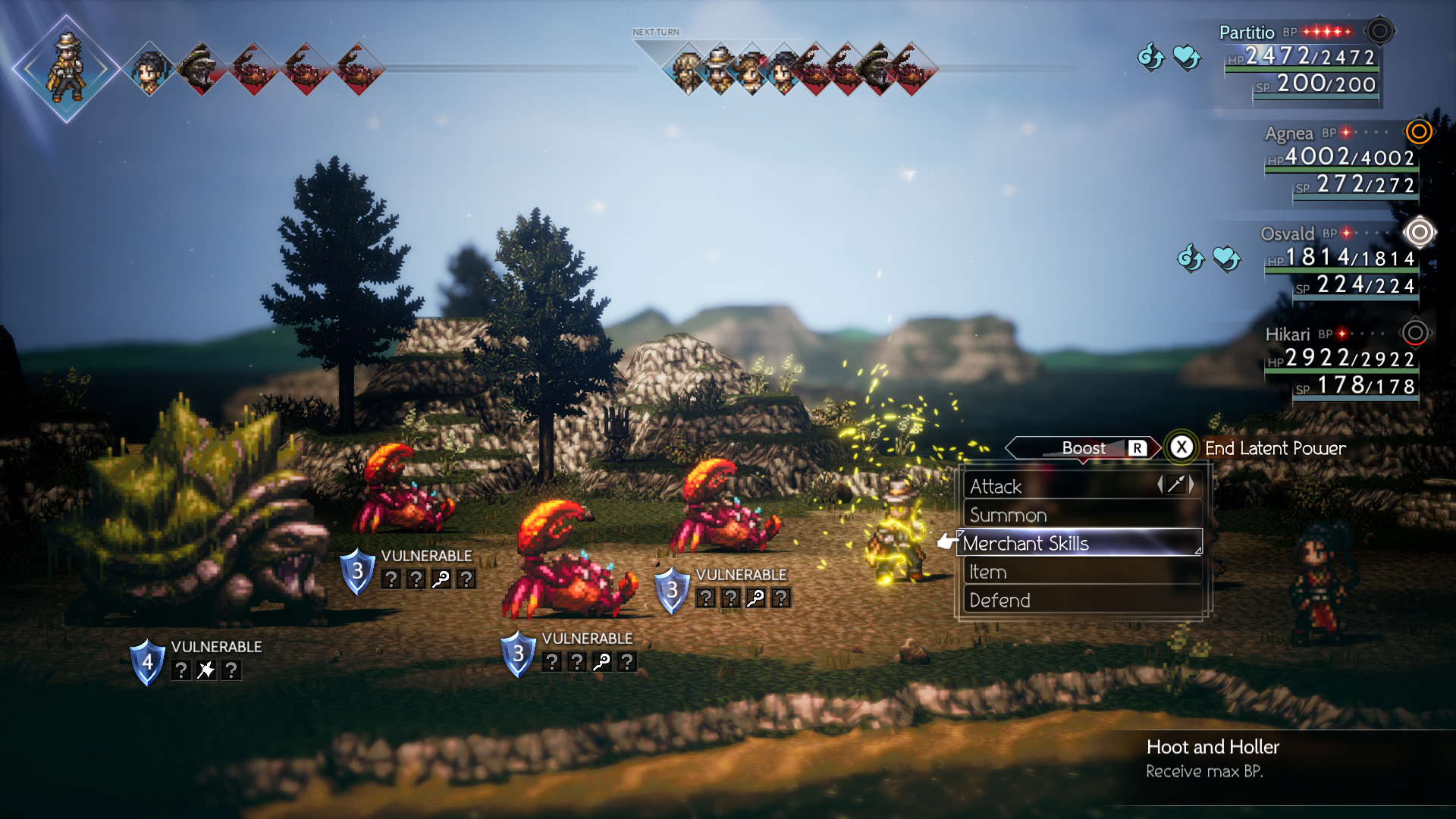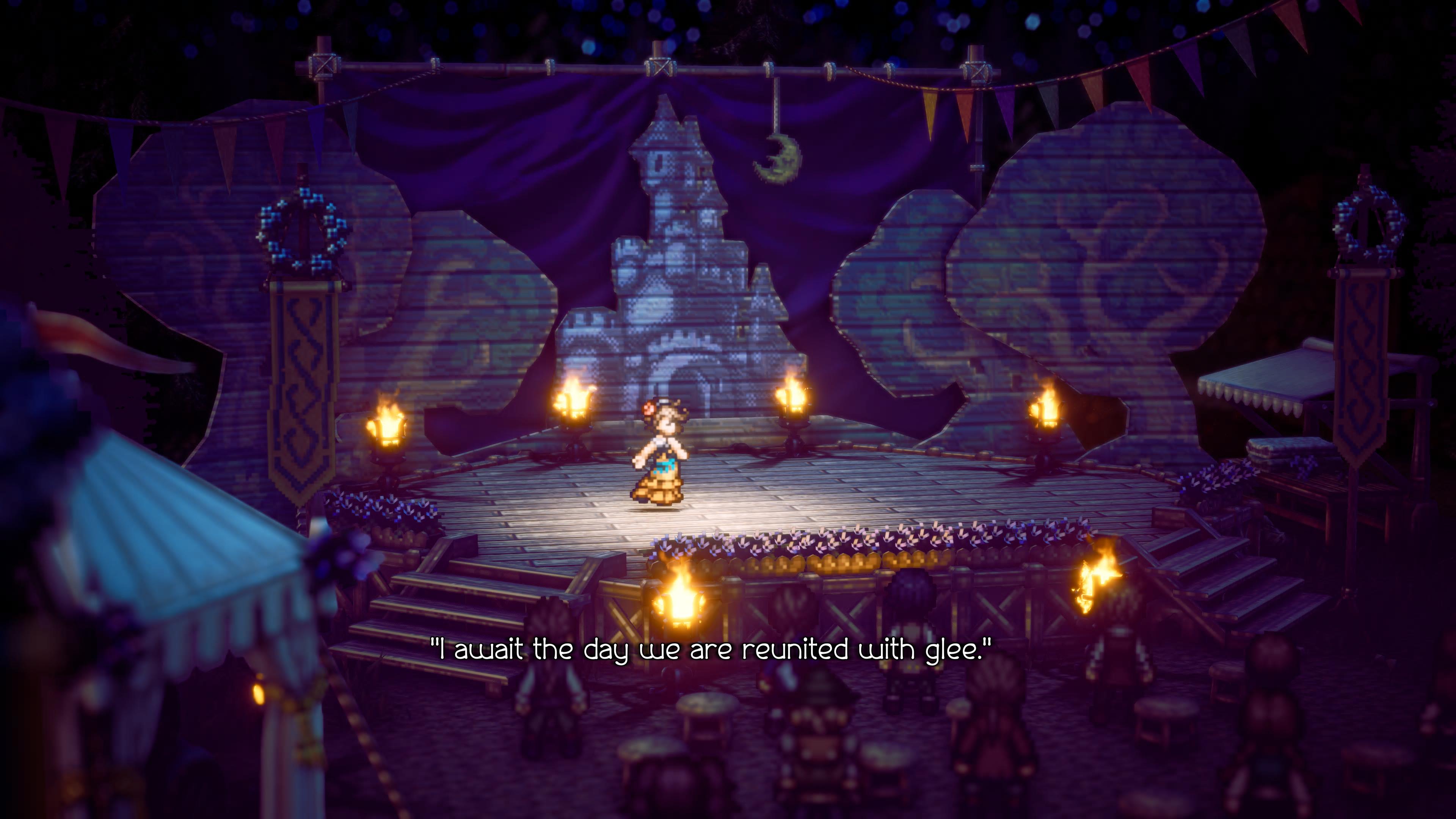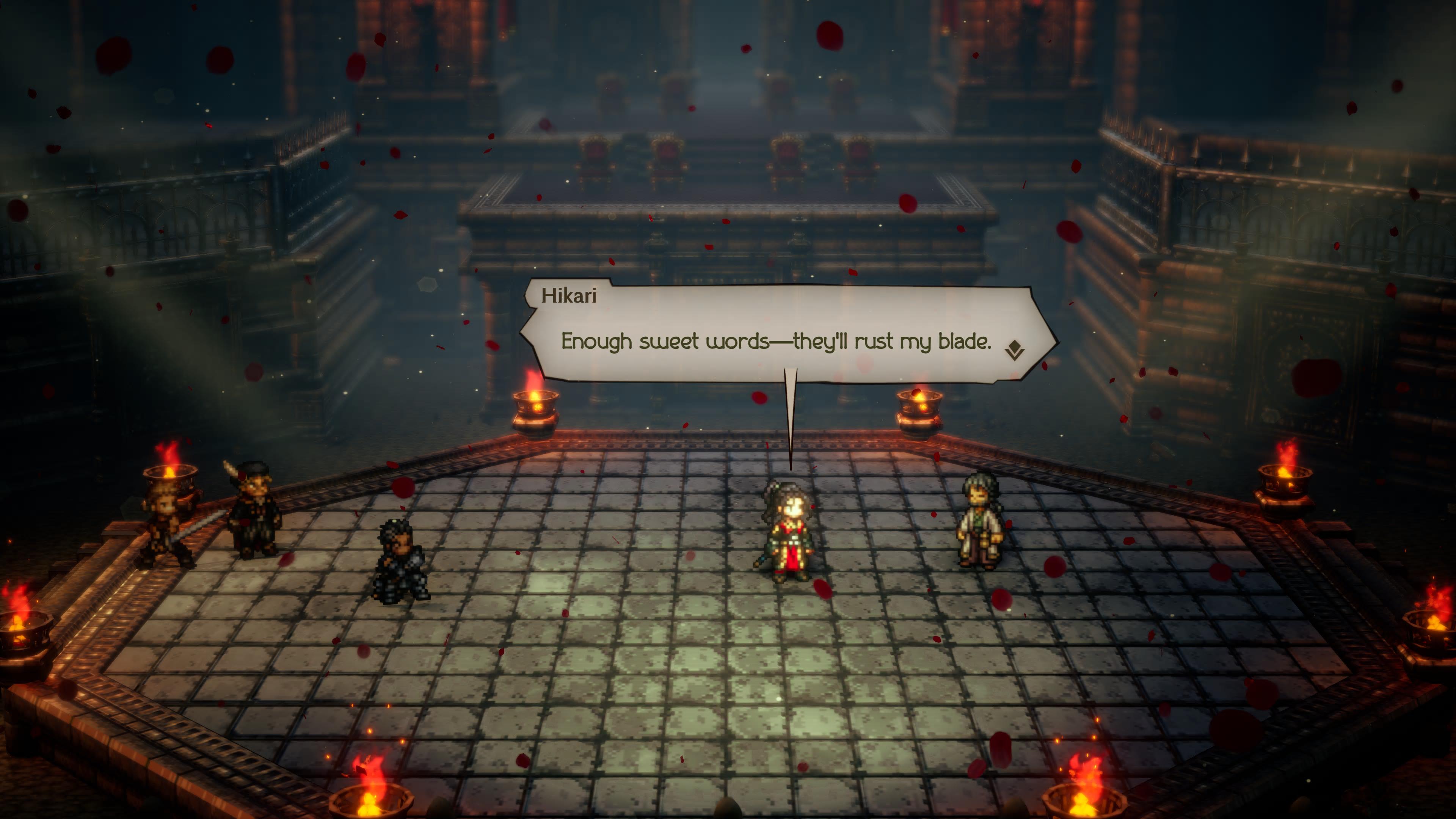Tom's Guide Verdict
Octopath Traveler II is a gorgeous retro-style JRPG with well-crafted characters, an engaging battle system, and stunning level and character design. It’s held back by the same weaknesses as the original:slow battle pacing, a steep difficulty curve, and a confusing anthology-style narrative.
Pros
- +
Complex but approachable battle system
- +
Well-crafted, intriguing characters
- +
Gorgeous retro 16-bit art style
Cons
- -
Slow battle pacing
- -
Less cohesive overall narrative
- -
Steep difficulty curve
Why you can trust Tom's Guide
Octopath Traveler II is the third instalment in the Octopath Traveler series, which is a loving homage to the classic turn-based JRPGs of the early Super Nintendo era. The game functions as something akin to an anthology, showcasing eight different stories tied to a group of eight protagonists which eventually overlap in the final chapter. You can complete these character stories sequentially if you wish, or you can juggle multiple stories at once since their difficulty does not scale as you level your party.
Each of the eight protagonists has their own motive for venturing out into the world, though their stories often mirror one another, which is reflected in their “travel banter” interludes. Because you have eight stories to complete, your objectives differ based on which character you’re focusing on at the time. You may be off to Winterbloom to find Castti’s memories, or perhaps you’ve ventured to town to try and kill the head of a crime syndicate. Many of the story chapters end with a challenging boss fight, but that’s not always the case. So the basic commonalities throughout the game are exploration of the game world, leveling up your characters, and customizing their gear.
Platform: Nintendo Switch, PlayStation 5, Playstation 4, PC
Price: $59.99
Release Date: February 24, 2023
Genre: role-playing game
Octopath Traveler II - Gameplay
Outside of combat, the gameplay experience of Octopath Traveler II focuses around exploration. Whether you’re just wandering around or taking part in one of the eight character stories or “crossed paths” tales, much of what you need to do is interact with the non-player characters (NPCs) and search out as much of the world as possible to either locate your objective, find hidden items, complete sidequests, or pick up helpful skills and allies.
The world of Octopath Traveler II consists of two different continents to explore, with several dungeons, shrines, towns, and cities to discover. Each of the eight travelers also has two different interaction abilities, allowing them to deal with the world around them. During the day, Castti and Osvald can learn information from the NPCs, while at night, Castti can administer medicine to them while Osvald can mug them for their valuables. These interactions are necessary for the traveler’s individual stories, but they can also help you access various discounts and items outside of their story-specific uses. So utilizing your character’s interaction abilities is a must.

While much of your exploration will be done on foot, there is a ship you can help build and take sailing on the open seas. Several locations are only available by boat, so it’s not a bad investment if you can afford it. The biggest setback in the gameplay experience overall is the steep difficulty curve about halfway through the game. Character story chapters each have a recommended level, which is fine at first. Many of the early chapters start at low level and continue at about level 15. Then there is a rather sizable gap between the second and third chapters which leaves you wandering around looking for zones where enemies aren’t too hard or too easy to defeat. That kind of a hard pause isn’t unheard of in old school JRPGs, and several of the classics essentially grind to a halt and force you to go out and level up before you can continue, but it is one of those aspects of old games that was more frustrating than enjoyable at the time and is only worse these days.
Octopath Traveler II - Battle System
When not running around the world, you’ll spend much of your time in Octopath Traveler II in combat. Octopath Traveler II uses the same turn-based battle system as the first game in the series, which is relatively easy to pick up. Each character gets to take one action per turn unless a skill or ability gives them the opportunity to take an additional action. Actions can be basic attacks, special job skills, use of an item, switching to a defensive stance, or fleeing. You can augment your turns with boost points generally earned each turn, which let you do things like increase the number of attacks you make or increase the power of a skill.
Get instant access to breaking news, the hottest reviews, great deals and helpful tips.

Each of the eight travelers has specific abilities of their own: Castti can make healing or destructive concoctions during battle, Hikari can learn skills from his opponents and use them, Temenos can “guide” an NPC and summon them into battle, and Ochette can have captured beasts fight for her. Each also has a ‘latent power’ which can further customize their capabilities in a fight. Hikari and Ochette have special abilities tied to their latent powers, Partitio can instantly fill his boost point gauge, and Throné can take multiple actions in succession. All eight characters are also capable of taking on a secondary job, further increasing their skills and available weapons. This gives you more room to customize your team and makes fights quicker and easier to finish.
Enemies each have a number of “shield points” which need to be broken with specific vulnerabilities, leaving them open to more devastating attacks. The basic strategy is to whittle down an enemy’s shield points and then use boosted attacks and skills to deal critical damage. However, there are cases where you may boost to get additional attacks per action, wearing down the enemy’s shield points faster. This leaves you with something of a “risk-reward” system that can make Octopath Traveler II’s combat challenging to master.

While many of the fights are exciting, you may find that your party is ill-equipped to handle certain bosses as their vulnerabilities may not match up well with your party’s weapon and skill options. There are five types of melee weapons in Octopath Traveler II in addition to six types of magic. So adding secondary jobs as you progress further in the game is practically essential.
Ultimately, the biggest drawback of Octopath Traveler II’s combat is its turn-based nature. Even at 2x speed, the fights can take a while to finish simply because of the time it takes for each character and enemy’s actions to resolve.
Octopath Traveler II - Narrative
As an anthology of eight stories, Octopath Traveler II is somewhat uneven. Many of the stories involve high-stakes situations from cosmic threats to religious intrigue, and then there’s Partitio and Agnea. While their stories do make sense for a merchant and a dancer, there’s far less at stake with either of these tales. Hikari is attempting to bring peace to a country that has only known war, and Partitio wants to bring prosperity to the world through capitalism. Ochette has to save her island from disaster, and Agnea wants to be a famous dancer bringing joy to the world. Partitio’s storyline is, perhaps, the most disappointing of the bunch given the current world economy and its overall message about capitalism being a tool for good, but there are at least some stakes in his tale. Agnea’s storyline is overall the weakest. While some art world intrigue does take place in later chapters, it seems even the development team wasn’t quite sure how to write a compelling hero story for a dancer.

As a game with eight connected characters who each view and interact with each others’ stories, Octopath Traveller II feels jumbled and disjointed. The cutscenes of each character’s chapter doesn’t include their other party members or the full cast, but will still use them in combat scenes. The crossed paths tales are interesting, but each party member is grouped with just one other character. While these pairings are interesting, it does leave the relationships with the rest of the cast relegated to short “travel banter” interludes that don’t ever delve too deep into any of their similarities or differences. And because these characters' stories don’t start to really converge until the Final Chapter, you’re often left wondering why any of these eight characters are even traveling together in the first place. Why would Agnea, who wants to be a famous dancer, ever pick up thief and assassin Throné as a travel companion? Why would Castti, who values all human lives equally, ever join Osvald’s revenge quest?

While the narrative of Octopath Traveler II is indeed one of its main selling points, it’s also the most frustrating aspect of the game because there are so many opportunities to make it a more cohesive narrative. Unfortunately, this “eight loosely connected characters” narrative is somewhat baked into the title by this point, as we are three games into the series.
Octopath Traveler II - Visuals and sound
The other primary selling point for Octopath Traveler II, and retro JRPGs in general, are the visuals. While the 16-bit sprites are rather dated by today’s standards, they do have a nostalgic aesthetic that calls back to classic Japanese RPGs. The character designs are interesting, the levels are all crafted well, and the choice of putting 2D characters in a 3D world pays off with fascinating results.
While Octopath Traveler II doesn’t look like a modern game, it does take a classic format and put a more modern spin on it with the 3D levels, front-on camera angle, and the way certain parts of the levels will disappear to give you access to areas “hidden” behind walls, pillars, or trees.
The sound design is also a big throwback to classic JRPGs. While not in the realm of chiptunes, the music is deeply evocative of the classic Final Fantasy games.

Octopath Traveler II - Verdict
Octopath Traveler II is a serious time investment. You have eight different stories to complete, plus four “crossed paths” interludes, and a Final Chapter. There’s also some extra end-game dungeons to take on as well. If you’d like to experience everything the game has to offer, you’d be looking at a game time of around 100 hours. And it's 100 hours of a single game that tries to do far too much at once.
There’s an oddly steep difficulty curve about halfway through the game which leaves you with a lot of dead time, with little external content to explore and little narrative to experience while you simply grind for levels on all of your party members.
While the battle system has a fascinating amount of complexity, it can also be slow moving. The narratives are individually pretty interesting, but don’t form a cohesive whole, leaving you with a rather disjointed experience. The retro visuals are at once faithful to their inspiration, while also being a more modern take on traditional JRPGs. Ultimately, Octopath Traveler II is a mixed bag. Most of it is good, and fans of turn-based JRPGs will enjoy the game, but it can be a difficult sell if you aren’t willing to overlook some of its major faults.

